|
|
Figure 1. Cisco Unified MeetingPlace Express Helps Users Make the Most of Their Meeting Time
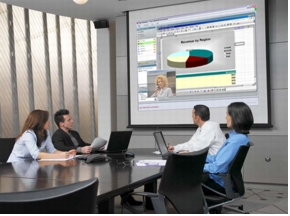
Product Overview
Improved Productivity, Accelerated Business
Cost Savings and Security
Easy Deployment and Management
Key Features and Benefits
Simple Conference Setup and Attendance
Figure 2. Easily Set Up a Voice and Web Conference from Microsoft Outlook
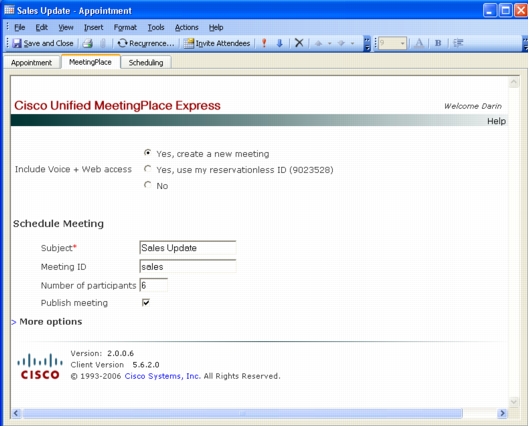
Figure 3. Attending from the Cisco Unified MeetingPlace Express Meeting Details Page
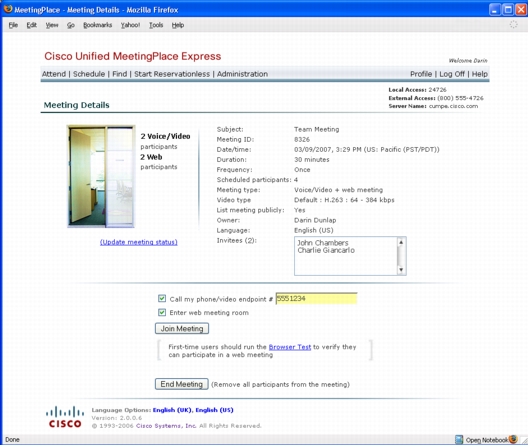
Advanced Voice, Web, and Video Conferencing
Figure 4. Cisco Unified MeetingPlace Express Offers Users a Consistent Web Conferencing Interface Across Platforms
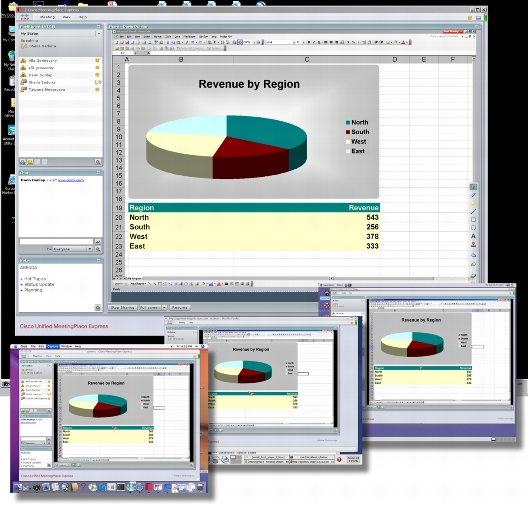
Figure 5. Cisco Unified MeetingPlace Express Participant List and Meeting Controls
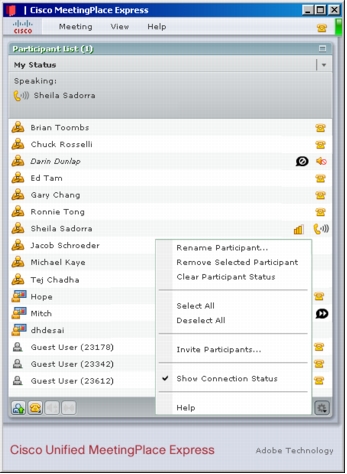
Figure 6. Web Conferencing Using Cisco Unified Personal Communicator
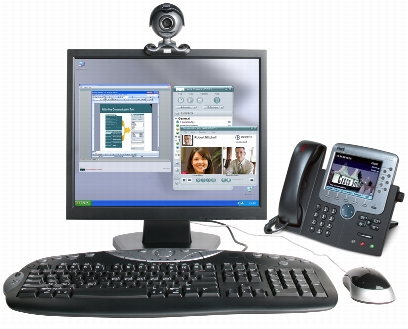
Figure 7. Cisco Unified MeetingPlace Express Phone View
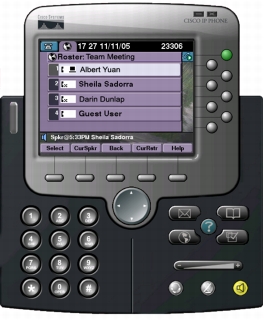
Product Architecture
• Telephony and video integration: Standards H.323, SIP, G.711, and G.729a are supported for telephony integration with Cisco Unified Communications Manager, Cisco Unified Communications Manager Express, and other standards-based call-control systems. H.263 or H.264 is supported for video communication. See Table 6 for more details on system requirements. In Cisco Unified Communications Manager environments, advanced conferencing capabilities are exposed on supported IP phones (such as the Cisco Unified IP Phone 7940) through Phone View, an Extensible Markup Language (XML) application.
• Web conferencing access: Web conferencing access is available from Windows, Mac OS, Linux, and Solaris platforms using standard browsers (such as Internet Explorer, Safari, and Firefox) and the Adobe Flash Player. Encrypted access is supported through HTTPS and SSL.
• Directory integration: Facilitate user profile setup and authentication through Lightweight Directory Access Protocol (LDAP) directory integration with Cisco Unified Communications Manager, or with Cisco Unified Communications Manager using other standard directories (such as Microsoft Active Directory).
• Microsoft Outlook and e-mail integration: Set up and attend meetings from Microsoft Outlook using a plug-in that communicates with the Cisco Unified MeetingPlace Express server using HTTP or HTTPS. E-mail notifications are enabled in e-mail environments supporting Microsoft Exchange or Simple Mail Transfer Protocol (SMTP).
• Network management: Monitoring and alarming are supported through the Simple Network Management Protocol (SNMP).
• On the internal network: This model provides for voice and video conferencing access from internal and external endpoints (using gateways), with Web conferencing access limited to those with access to the internal network.
• Segmented meeting access: This model addresses the need to make some Web meetings available to external users, for example partners and customers, while also keeping internal Web meetings, for example confidential forecast meetings, protected from Internet access. An additional server is placed in a demilitarized zone (DMZ) and provides Internet access to Web conferences set up to allow external participants.
Product Specifications
Table 1. Product Specifications
|
Hardware compatibility |
Cisco Media Convergence Servers • Voice, Web, and video conferencing media convergence server part numbers: MCS-7825-H3-RC1, MCS-7825-I3-RC1, MCS-7825-H2-RC1, MCS-7825-I2-RC1, MCS-7825-H1-RC1, MCS-7825-I1-RC1, MCS-7835-H2-RC1, MCS-7835-I2-RC1, MCS-7835-H1-RC1, MCS-7835-I1-RC1, MCS-7845-H2-RC1, MCS-7845-I2-RC1, MCS-7845-H1-RC1, and MCS-7845-I1-RC1
• Media-convergence-server part numbers for voice conferencing with lite meeting room only: MCS-7825H-3.0-IPC1, MCS-7825I-3.0-IPC1, MCS-7835H-3.0-IPC1, MCS-7835I-3.0-IPC1, and MCS-7845H-3.0-IPC1 (supports Web conferencing)
• Plus exact equivalent third-party servers (for information visit http://www.cisco.com/go/swonly; DVD drive required)
|
|
Software compatibility-server |
Cisco Linux-based operating system (included with system software orders) |
|
Software compatibility-client |
Microsoft Windows • Operating system: Windows 2000 Pro (SP2 or later), Windows 2000 Server Edition (SP2 or later), Windows 2000 Advanced Server (SP2 or later), Windows XP (SP1 or later), or Windows Vista (Business or Enterprise)
• Browser: Internet Explorer 5.5 or later; Netscape 7.1 or later; Mozilla 1.6 or later; or Firefox 1.0.3 or later
• Adobe Flash Player: 8 or later
Apple Macintosh • Operating system: Mac OS 9.2* or Mac OS 10.2 or later
• Browser: Safari 1.1 or later; Netscape 7.1 or later; Mozilla 1.2.1* or 1.6 or later; or Firefox 1.0.3 or later
• Adobe Flash Player: 8 or later
Linux** • Operating system: Red Hat 9 or Red Hat Enterprise Linux 3 or later
• Browser: Netscape 7.1 or later; Mozilla 1.4 or 1.6 or later; or Firefox 1.0.3 or later
• Adobe Flash Player: 8 or later
Sun Solaris** • Operating system: Solaris 9 or Solaris 10
• Browser: Netscape 7.1; Mozilla 1.4 or 1.7 or later; or Firefox 1.0.3 or later
• Adobe Flash Player: 8 or later
|
|
Protocols |
• H.323 v4
• SIP (RFC 3261)
• G.711 and G.729a***
• Real-Time Transport Protocol (RTP; RFC 3550)
• RTP Payload for Dual Tone Multifrequency (DTMF]) Digits (RFC 2833)
• Session Description Protocol (SDP; RFC 2327)
• IPv4
• LDAPv3
• SMTP (RFC 2821)
• SNMP Versions 1, 2c, and 3
• HTTPv1.1
• SSL Versions 2 and 3 (optional; customer provides certificates obtained from a broadly trusted certificate authority)
• Network Time Protocol (NTP) Versions 3 and 4
|
|
MIBs |
MIB-2, SYSAPPL-MIB, CISCO-CDP-MIB, CISCO-SMI, CISCO-TC, CISCO-VTP-MIB, and CISCO-LATITUDE-MIB |
|
Network connectivity and bandwidth |
Server: Two 100-Mbps or faster Ethernet connections Client • Phone: G.711 requires at least 84 kbps of available bandwidth in each direction; less bandwidth is required to the phone if using G.729a or transcoding a compressed codec (such as G.729a) to G.711
• Video conference: 64 to 768 kbps (quality increases with bit rate)
• Web conference: At least a 56-kbps modem connection or faster****
|
*On Mac OS 9.2, Mozilla 1.2.1 is the only supported browser. Sharing a screen from Mac OS 9.2 is not available.
System Capacity
Table 2. System Capacity
|
Platform Part Number |
Voice Conferencing Capacity |
Web Conferencing Capacity |
Video Conferencing Capacity 1 |
Recording Capacity |
|
MCS-7845-H2-RC1 and |
20 to 200 concurrent users2 |
6 to 200 concurrent users3 |
6 to 150 concurrent users |
3200 hours of voice recordings4 |
|
20 to 200 concurrent users |
0 concurrent users5 |
6 to 200 concurrent users |
||
|
MCS-7845-H1-RC1 and |
20 to 200 concurrent users |
6 to 200 concurrent users |
6 to 120 concurrent users |
|
|
20 to 200 concurrent users |
0 concurrent users |
6 to 200 concurrent users |
||
|
MCS-7835-H2-RC1 and |
20 to 120 concurrent users |
6 to 120 concurrent users |
6 to 100 concurrent users |
2000 hours of voice recordings6 |
|
MCS-7835-H1-RC1 and |
20 to 120 concurrent users |
6 to 120 concurrent users |
6 to 40 concurrent users |
|
|
MCS-7825-H3-RC1, |
20 to 40 concurrent users |
6 to 40 concurrent users |
6 to 40 concurrent users |
2000 hours of voice recordings |
|
MCS-7845H-3.0-IPC1 |
20 to 180 concurrent users |
6 to 120 concurrent users |
6 concurrent users |
3200 hours of voice recordings |
|
MCS-7835H-3.0-IPC1 and |
20 to 120 concurrent users |
6 concurrent users |
6 concurrent users |
150 hours of voice recordings7 |
|
MCS-7825H-3.0-IPC1 and |
20 to 40 concurrent users |
6 concurrent users |
6 concurrent users |
150 hours of voice recordings |
|
1For 384 kbps or lower video; refer to the Solution Expert sizing tool if higher bit rate is needed.
2Includes support for the noted number of concurrent users of the lite Web meeting room (for example, participant list and telephony controls); assumes G.711 is used; refer to the Solution Expert sizing tool if other codec is needed.
3When SSL is enabled, 170 is the maximum.
4For 144-GB hard-drive system
5For systems with high voice, video, and Web capacity needs that the other supported configurations in this table do not address, refer to Table 3 for support of greater Web conferencing capacity on a separate server. Note that moving to this configuration includes support for deploying the Web conferencing server in a DMZ, but it does not include support of internal versus external Web conferences.
6For 72-GB hard-drive system
7For 36-GB hard-drive system
|
Table 3. Web Conferencing Capacity on Additional Server
Features
Voice and Video Conferencing
• Real-time mixing of up to three simultaneous speakers
• Adjustable input volume (gain) of each participant
• Voice-activated video switching, which shows the person who is speaking to each video participant
• Support for the H.263 or H.264 video codec (per meeting)
• Video bit rates from 64 to 768 kbps (one per scheduled or reservationless meeting) in Common Intermediate Format (CIF) video resolution
• Entry and exit notification: beep plus name, beep, or silent
• Recording (voice) and playback (MP3)
• Breakout sessions (voice and video; up to nine simultaneously per meeting)
• Automatic extension of meetings if capacity is available
• End-of-meeting warning
Meeting Management
• Touchtone phone: A voice prompt interface that allows users to specify commands and responses using the telephone keypad
• Web meeting room: A Web browser interface that provides meeting management capabilities from a computer; systems with Web conferencing have additional capabilities noted later in the "Web Conferencing" section
• Phone View: An XML application that provides visual meeting management capabilities on supported Cisco Unified IP phones
Table 4. Meeting Information
*Voice participants
Table 5. Meeting Management
Web Conferencing
• Easy access: Users easily access meetings from a variety of platforms using Web browsers and the broadly installed Adobe Flash Player.
• Firewall friendly: HTTP and HTTPS tunneling technology allows users behind firewalls to participate in Web conferences.
• Connection speed optimization: Cisco Unified MeetingPlace Express optimizes the Web conference performance to available bandwidth based on the user's selected connection speed.
• Screen sharing: Real-time screen sharing allows users to show others' applications, windows, or their entire desktop. A variety of sharing controls is available from the meeting room, the operating system, and the shared applications or windows. Option to use 24 bit color sharing is available for color and graphic intensive applications.
• Flexible viewing options: Shared content can be viewed in a variety of ways to best suit the user.
– Scaled view: Users see a view of the shared content that scales to fit the space available.
– Scrolled view: Users see a full-size view of the shared content that may require scrolling to see the entire shared screen.
– Meeting-room view: Users see the shared content in addition to the other pods. Either the scaled or scrolled view can be used.
– Full-screen view: Users see only the shared content on their screens. Controls are available to select whether the full-screen view is effective for everyone or individuals, as well as if users can toggle the full screen themselves.
• Remote Control: Users can request control of shared application, document, or desktop to collaborate or provide remote assistance. Control is granted by the person sharing the application, document, or desktop and can be revoked with a single click.
• Annotations: Users can collaborate over shared screens using markup tools such as a pencil, marker, line, rectangle, ellipse, text, and stamper. A variety of options is available to print and edit annotations, including undo, redo, change color, change size, move, and delete.
• Chat: Users can send text messages to each other privately, to presenters, or to everyone. Options are available to control text size, select who can chat, determine if one sees chat notifications when the chat tool is not available, and clear the chat history.
• Notes: Users can use the note tool to type up a meeting agenda, track action items, or do anything else that requires that text be made visible to all in the meeting. Options are available for text size, text alignment, and creating and accessing multiple notes.
Meeting Setup and Attendance
• Integrated voice, Web, and video conference setup: Users can quickly and easily schedule and reschedule integrated voice, Web, and video meetings in a single step from Microsoft Outlook and a variety of Web browsers.
• Meeting types: Cisco Unified MeetingPlace Express supports the following meeting types:
– Scheduled: Users can reserve meeting resources in advance using Microsoft Outlook or a Web scheduling interface. A user's delegates also can schedule meetings.
– Recurring: This type of scheduled meeting occurs at regular intervals (for example, weekly on Mondays for four weeks) and can be set up from Microsoft Outlook or the Web interface.
– Continuous: This type of scheduled meeting is always available; it is set up from the Web interface and is commonly used for crisis management.
– Reservationless: Users can hold meetings using a personal meeting ID without the need for advance scheduling. Reservationless meetings can be initiated from Microsoft Outlook, a touchtone phone, the Web, or Phone View.
– Impromptu Web conferencing: From Cisco Unified Personal Communicator, users can launch a simple screen-sharing interface on demand.
• E-mail invitations: Meetings set up from the Web interface or Microsoft Outlook can generate Microsoft Outlook calendar invitations that include the ability to easily populate a user's calendar with the meeting information, which is highly customizable by the system administrator. Using standard SMTP e-mail, invitations can be sent to meeting invitees in either HTML or text format.
• Flexible attendance options: Users have numerous options available when attending meetings:
– Dial in: Users have a couple of options to dial into a meeting:
- Dial into Cisco Unity Connection (2.0 or later) and use speech (that is, say "Join meeting") to access an active meeting associated with the user
- Dial directly into the voice and video meeting using the dial-in number, and when using a recognized phone, the user is automatically logged into the system and directed to her meeting
– Click-to-attend link: Users can click a URL in Outlook and in e-mail invitations that takes them to a Webpage providing an option to attend the voice, Web, and video meetings simultaneously.
– Join from the Web: Users can go to the system Website and either find the meeting or specify the meeting ID to reach a Webpage providing options to dial out to a specified phone or video endpoint and join the Web meeting.
– Dial out from Phone View: Users with supported Cisco Unified IP phones can find the meeting or specify the meeting ID to have the system call their IP phone.
– Find me: Users can specify a series of phone numbers with which they are associated by user profile, and the system calls these numbers when a meeting starts.
Administration
• Web administration center: A Web interface provides system administration capabilities for user management, system configuration, maintenance, reporting, monitoring, and interface configuration.
• User provisioning: User profile creation can be handled in the following ways:
– Automated profile creation: Directory integration (for example, with Cisco Unified Communications Manager) automates profile creation by establishing an account on Cisco Unified MeetingPlace Express the first time a user successfully authenticates using credentials accepted by the integrated directory.
– Profile import: User profiles can be batch imported into the system.
– Manual profile creation: Using the Web administration interface, profiles can be manually added to the system.
• Group management: Groups can be created and associated with user profiles to facilitate administration of similar user types.
• System configuration and maintenance: Numerous parameters and options are available to configure and maintain the system:
– Usage configuration: Twelve- or 24-hour time, attendant dial-out, language configuration, minimum password lengths, password expiration, alarm dial-out, guest dial-out, directory integration parameters, and system phone numbers and labels
– Meeting configuration: Capacity and codec management, overbooking, maximum and default meeting sizes, maximum and default meeting lengths, meeting ID guard times, meeting extension, meeting warnings, minimum meeting password length, advance scheduling limit, meeting and recording purging, minimum meeting ID length, vanity meeting IDs, reservationless parameters, and hosting option for Web meetings
– Video configuration: Ability to manage the types of video meetings made available to end users
– Microsoft Outlook plug-in configuration: Configuration parameters that are automatically set in the plug-in for setting up and attending meetings from Microsoft Outlook
– Call configuration: H.323, SIP, dial-out, direct meeting dial-in, and IP voice and video parameters, and digit handling for automated phone login and attend
– E-mail configuration: SMTP servers, Microsoft Exchange server, Exchange user account, and e-mail templates
– SNMP settings: Community strings and notification destinations
– Licensing: Installing and viewing licenses
– Backup: Backing up and archiving, local and remote configuration, and e-mail notification
– E-mail blast: E-mail sent to a group or all users with a message regarding the system
– Import information: Importing of settings for groups and meetings (such as batch updates), as well as transferring meetings from Cisco Conference Connection
– SSL certificate management: Installing, enabling, and managing SSL certificates
• Reporting and monitoring: Numerous predefined reports, data exports, and monitoring and alarm tools are provided:
– Meeting cancellation report: Details about canceled meetings
– Billing report: Minutes of voice and Web conferencing that can be billed by billing code
– Usage report: Capacity usage report comparing scheduled versus used resources
– Disk usage report: Details about hard-disk usage and available space
– Data export: Export data for external analysis and reporting, including information about user profiles, groups, meeting details, dial-out activity, meeting participants, participants attending and exiting meetings, and scheduling failures
– E-mail queue status report: Tool to monitor and manage e-mail notifications in queue
– Media statistics reports: Statistics and information regarding conference media
– In-session monitoring: Tool to monitor active meetings
– System logs: A variety of system logs for monitoring and troubleshooting
– Alarms: Viewing and exporting system alarms
– System status: Viewing a snapshot of system status for monitoring and troubleshooting
• Interface configuration: The interface can be configured for voice prompts and a select set of Webpages:
– Voice prompts: Install custom voice prompts that are played on the phone
– Custom logo: Add a company or other logo to Webpages
– Schedule meeting page: Configure fields that are available to users on the scheduling page
– User profile page: Configure fields that are available to users on the user profile page
– Outlook plug-in download: Select Webpages from where the Outlook plug-in can be downloaded
• Multilanguage support for voice prompts: English (United States), English (United Kingdom), English (Australia), French (France), French (Canada), German, Japanese, Korean, Chinese (China), Chinese (Taiwan), Spanish (Latin America), Spanish (Spain), Italian, Dutch, Swedish, Russian, Danish, and Portuguese (Brazil) are supported.
• Multilanguage support for Web interfaces: English (United States), French (France), German, Japanese, Korean, Chinese (China), Chinese (Taiwan), Spanish, Italian, Dutch, Swedish, Russian, Danish, and Portuguese (Brazil) are supported.
Security
• Dedicated on-net system: The dedicated Cisco Unified MeetingPlace Express system is integrated with the organization's private network. Maximum security can be provided by deploying the system such that only those on the private network can access meetings.
• Built-in defense against attacks: Cisco Security Agent is built in to the system at the kernel level to allow only application-specific activities and to defend against attacks.
• Segmented meeting access: Web meetings can be set up either as internal meetings and held entirely behind the corporate firewall, or as external meetings, which are also accessible to Internet participants. Administrators and meeting organizers have complete control.
• Access authentication: In addition to using the option of a meeting password, meeting organizers can require that participants authenticate themselves using individual logins to attend a meeting and to access the associated recording. Further, Cisco Unified MeetingPlace Express can automatically block out users after multiple failed login attempts.
• Integrated authentication: Cisco Unified MeetingPlace Express integrates with corporate directories (such as Cisco Unified Communications Manager) to make authentication consistent across systems.
• Encryption: Cisco Unified MeetingPlace Express supports encrypted Webpages and Web conferencing traffic using SSL. User passwords are encrypted in the database using a one-way hash.
• In-session meeting controls: Meeting owners can change Web conferencing permissions, specify announced entry and departure, require passwords, lock the meeting, and eject unwanted attendees.
System Requirements
Table 6. System Requirements
*H.323 call-control systems and video endpoints must be capable of supporting midcall video escalation and de-escalation. Upon joining the meeting, Cisco Unified MeetingPlace Express negotiates the video session by sending a second H.245 Terminal Capabilities Set message indicating the video compression in use for the meeting. H.323 call-control systems and endpoints must also support H.245 alphanumeric or H.245 signal dual tone multifrequency (DTMF) relay for transmitting digits.
Ordering Information
Table 7. Ordering Information
Cisco Services
For More Information